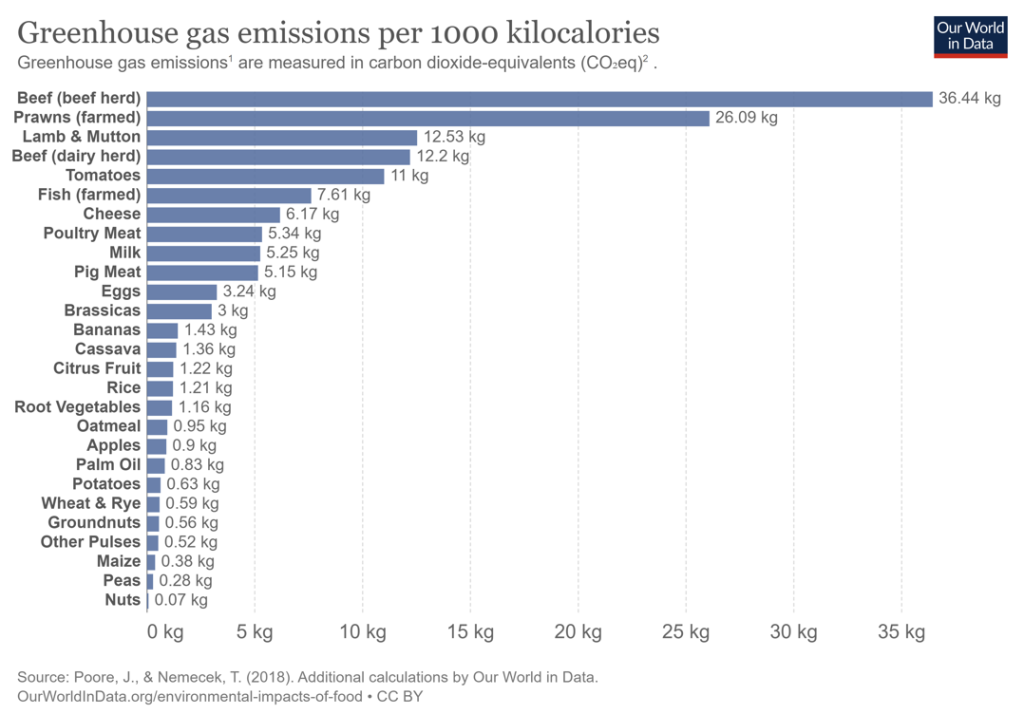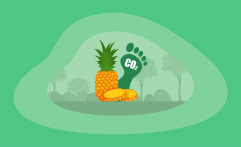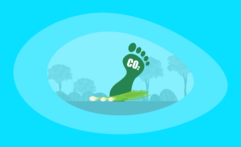What Is the Carbon Footprint of Grapes? A Life-Cycle Analysis
Impactful Ninja is reader-supported. When you buy through links on our site, we may earn an affiliate commission.
Learn more
Learn more
.
Hey fellow impactful ninja ? You may have noticed that Impactful Ninja is all about providing helpful information to make a positive impact on the world and society. And that we love to link back to where we found all the information for each of our posts. Most of these links are informational-based for you to check out their primary sources with one click. But some of these links are so-called "affiliate links" to products that we recommend. First and foremost, because we believe that they add value to you. For example, when we wrote a post about the environmental impact of long showers, we came across an EPA recommendation to use WaterSense showerheads. So we linked to where you can find them. Or, for many of our posts, we also link to our favorite books on that topic so that you can get a much more holistic overview than one single blog post could provide. And when there is an affiliate program for these products, we sign up for it. For example, as Amazon Associates, we earn from qualifying purchases. First, and most importantly, we still only recommend products that we believe add value for you. When you buy something through one of our affiliate links, we may earn a small commission - but at no additional costs to you. And when you buy something through a link that is not an affiliate link, we won’t receive any commission but we’ll still be happy to have helped you. When we find products that we believe add value to you and the seller has an affiliate program, we sign up for it. When you buy something through one of our affiliate links, we may earn a small commission (at no extra costs to you). And at this point in time, all money is reinvested in sharing the most helpful content with you. This includes all operating costs for running this site and the content creation itself. You may have noticed by the way Impactful Ninja is operated that money is not the driving factor behind it. It is a passion project of mine and I love to share helpful information with you to make a positive impact on the world and society. However, it's a project in that I invest a lot of time and also quite some money. Eventually, my dream is to one day turn this passion project into my full-time job and provide even more helpful information. But that's still a long time to go. Stay impactful,Affiliate Disclosure
Why do we add these product links?
What do these affiliate links mean for you?
What do these affiliate links mean for us?
What does this mean for me personally?
![]()
Grapes are a delicious and versatile fruit, with 30% being consumed directly, and the other 70% used to make wine. Originating as a crop around 8,000 years ago, they have a long agricultural history as well. But grapes can also have a significant impact on the environment. Many of the resources used to produce and distribute grapes can emit a lot of carbon. So, we had to ask: What is the carbon footprint of grapes?
Grapes have a carbon footprint of 0.64 kg (1.42 lbs) of CO2e per pound of grapes. This is mainly because of their irrigation, high pesticide use, refrigeration requirements during transportation, and high levels of packaging. Their footprint is especially high compared to other fruits.
In this article, we will look at the full life-cycle of grapes, investigating how each stage contributes to their carbon footprint. We will go through all of the main stages of grapes’ production—starting with growth and then going through harvesting, processing, transportation, and ending at waste disposal—and will evaluate how each stage contributes to grapes’ carbon footprint. So, let’s get into the carbon footprint of grapes!
Here’s How We Assessed the Carbon Footprint of Grapes
The carbon footprint is one of the ways we measure the effects of our human-induced global climate change. It primarily focuses on the greenhouse gas (GHG) emissions associated with consumption, but also includes other emissions such as methane (CH4), nitrous oxide, and chlorofluorocarbons, and is generally expressed in carbon dioxide equivalents (CO2e).
“Carbon footprint: the amount of greenhouse gases and specifically carbon dioxide emitted by something (such as a person’s activities or a product’s manufacture and transport) during a given period”
Merriam Webster
Basically, it is the amount of carbon emitted by you as an individual or an organization providing you with goods and services – including grapes:
- This includes GHG emissions from producing the products that we use and foods that we eat (e.g., power plants, factories or farms, and landfills)
- GHG emissions from fuel that we burn directly or indirectly (e.g., logistics and transportation, cooling or heating facilities),
- as well as the GHG emissions attributed to how we consume these products and foods.
To understand the carbon footprint of grapes, we must assess their life-cycle and each stage’s sustainability. This life-cycle assessment (LCA) is a method to evaluate the environmental impacts of products and materials.
Here’s the Overall Carbon Footprint of Grapes
The overall carbon footprint of grapes is 0.64 kg (1.42 lbs) of CO2e per pound of grapes. The main contributing factors to this carbon footprint are irrigation requirements, pesticide use, and high levels of packaging.
The carbon footprint of grapes is fairly high when compared with other fruits. There are a few factors that contribute to this comparatively high number, including the distance and method of transportation, as well as the type of pesticides used.
| The carbon footprint of grapes | 0.64 kg (1.42 lbs) of CO2e per pound of grapes |
So, let’s have a look at each stage of the LCA of grapes!
| The life-cycle stages of grapes | Each stage’s carbon footprint |
| Growing of grapes | The carbon footprint of growing grapes is moderate. This is mainly due to their necessary irrigation and tendency to use a high amount of pesticides. |
| Harvesting, processing, and packaging of grapes | The carbon footprint of harvesting, processing, and packaging grapes is moderately high. The main contributor is their excessive use of packaging, especially materials like styrofoam and plastic. |
| Transporting of grapes | The carbon footprint of transporting grapes is moderate to low. This is mainly because the majority of American-consumed grapes are grown in California, but they do have to travel in refrigerated trucks. |
| End-of-life of grapes | The carbon footprint of the end-of-life of grapes is fairly significant. This is primarily due to low composting rates, as well as low recycling rates of plastic and styrofoam. |
When looking at the overview of the stages of grape production, we can see that growth and end-of-life have the most significant impact on grapes’ carbon footprint. These are the bigger summaries of each stage of grapes’ impact. But each of those categories has a more complex story to tell. In the ensuing sections, we will dive deeper into each aspect of grapes’ production process.
What Is the Carbon Footprint of Growing Grapes
The carbon footprint of growing grapes is moderate. This is mainly due to their necessary irrigation and tendency to use a high amount of pesticides.
The process of growing grapes has a comparatively moderate carbon footprint, depending on the methods used. Factors like the amount of irrigation, deforestation, and pesticide use can all contribute to the overall impact of the growth stage.
Which factors impact the carbon footprint of growing grapes?
- How do grapes grow: Grapes are grown on vines in farms known as vineyards. Remarkably, grape vines can actually sequester carbon through photosynthesis, a process that can help offset some of the emissions created in the growth period. Thus, the grape growth method has a low carbon footprint.
- What is the growth duration of grapes: Grapes take around three months to go from flower to mature fruit. This is fairly short among fruits, meaning that grapes require comparatively less resources over the course of their growth journey. Because of their low growth time, this stage contributes minimally to grapes’ overall carbon footprint.
- What is the land usage of grapes: Grapes can yield between 20 and 50 tons per hectare. This is a fairly high yield, which means that a lower amount of land is needed to produce grapes. Because of this, land usage contributes minimally to grapes’ carbon footprint.
- What is the water usage of grapes: Grapes need around 25–30 inches of water per year. However, the vast majority of grapes in the US are grown in California, which gets around 23 inches of rainfall a year. So, irrigation is required. Irrigation does produce carbon emissions, which means that the water stage of grape-growing does contribute moderately to their carbon footprint.
- What is the pesticide and fertilizer usage of grapes: Unfortunately, grapes are some of the worst offenders when it comes to pesticides. One study found them to be the most pesticide-laden fruit, with over 87% of sampled fruit containing pesticides, compared to just 15% of mangoes. Pesticides have a high carbon footprint, so the pesticide use of grapes does contribute significantly to grapes’ overall carbon footprint.
The main aspects of the growth stage that contribute the most to grapes’ overall carbon footprint are irrigation and pesticide use. Grapes need a certain amount of supplemental water to keep them hydrated, and many grape farms use an exceptionally high amount of pesticides. Though they score low in the areas of growth method, duration, and land use, grapes still come out with a moderate growth carbon footprint.
In short, the growth stage contributes moderately to grapes’ carbon footprint. The requirement for irrigation and their bad pesticide track record are the main contributing factors to this stage’s footprint.
What Is the Carbon Footprint of Harvesting, Processing, and Packaging Grapes
The carbon footprint of harvesting, processing, and packaging grapes is moderately high. The main contributor is their excessive use of packaging, especially materials like styrofoam and plastic.
The next major stage in the life-cycle of grapes’ carbon emissions is harvesting, processing, and packaging, which involves picking the fruit, checking it for damage, sorting it, and getting it ready for distribution. This stage can contribute greatly to the carbon footprint of the fruit.
Which factors impact the carbon footprint of harvesting, processing, and packaging grapes?
- How are grapes harvested: Grapes are, for the most part, hand-harvested. This means that there is no (direct) energy required to pick the grapes, and so it contributes very minimally to their overall carbon footprint.
- How are grapes processed: Grapes are typically packed by hand as they are picked. Because this doesn’t require any direct energy to run, the processing of grapes does not contribute significantly to their carbon footprint.
- How are grapes packaged: Grapes are packaged in either cardboard boxes, styrofoam boxes, or plastic bags and containers. Cardboard, plastic, and styrofoam produce carbon emissions, meaning that this part of the process does contribute significantly to the overall carbon footprint of grapes.
When it comes to the handling of grapes during their harvesting and processing stages, there is an almost negligible carbon footprint. However, once you factor in the emissions required to create grape packaging, their harvesting, processing, and packaging carbon footprint becomes high.
In short, harvesting, processing, and packaging grapes have a moderate carbon footprint. Despite their manual harvesting and processing, the high amount of packaging drives up their footprint.
What Is the Carbon Footprint of Transporting of Grapes
The carbon footprint of transporting grapes is moderate to low. This is mainly because the majority of American-consumed grapes are grown in California, but they do have to travel in refrigerated trucks.
A grape’s journey has just started when it is packaged. They then have to travel the distance between the farm and the grocery store. The distance, as well as the method through which they have to travel, are the two most important factors in determining the carbon footprint of their transportation.
Which factors impact the carbon footprint of transporting grapes?
- Where are grapes grown: The majority of American grapes are grown in California, which don’t have to travel nearly as far as fruit from other countries or continents. This helps their carbon footprint. However, considering that most Americans live in the Eastern half of the country, many grapes still have to travel a considerable distance to the consumer. Thus, the carbon footprint of transporting grapes varies depending on where you live.
- How are grapes transported: Grapes have to be transported in refrigerated trucks to help keep them fresh. Unfortunately, refrigerated trucks consume much more carbon than regular trucks, meaning that this stage increases their carbon footprint.
Overall, there is some carbon that goes into the process of transporting grapes, but not considerably more than other fruits. So, grapes have a fairly moderate to low transportation footprint.
In short, the carbon footprint of transporting grapes is balanced by domestic production and the more carbon-costly refrigerated trucking.
What Is the Carbon Footprint of the End-of-Life of Grapes
The carbon footprint of the end-of-life of grapes is fairly significant. This is primarily due to low composting rates, as well as low recycling rates of plastic and styrofoam.
Grapes’ carbon footprint journey isn’t done after you consume them. In fact, one of the most important factors that will determine the overall carbon footprint of grapes is how its waste is disposed of. Here, we will look at how this stage in the process affects grapes’ carbon footprint.
Which factors impact the carbon footprint of the end-of-life of grapes?
- How are grapes disposed of: Grapes have stems and sometimes seeds that cannot be eaten, but they are both technically biodegradable. Unfortunately, only 4% of food is composted. This means that the majority of food waste ends up in landfills. Furthermore, throwing food waste in landfills generates methane, which is a very harmful greenhouse gas. Therefore, the organic waste of grapes does contribute significantly to their carbon footprint.
- How is the packaging of grapes disposed of: Grapes have three types of packaging: cardboard, plastic, and styrofoam. Cardboard has a remarkable recycling rate at 89%, plastic has a low recycling rate, at around 9%, and styrofoam has by far the lowest, at around 1%. So, if your grapes come in any of these packaging materials, especially the latter two, they will have a significant packaging waste carbon footprint.
Though all the waste involved with grapes can theoretically be composted or recycled, in practice a lot of it ends up in landfills. As a result, the end-of-life stage contributes very significantly to grapes’ carbon footprint.
In short, grapes’ end-of-life has a fairly high carbon footprint. When you take into account how most organic waste, as well as most plastic and styrofoam waste, is ending up in landfills, you can see how this stage can really drive up grapes’ overall carbon footprint.
How Does the Carbon Footprint of Grapes Compare to Other Types of Food
In comparison to other fruits, grapes have a significant carbon footprint. In terms of fruits, they are one of the highest carbon emitters, and amongst food in general, they are in the top half of foods ranked. When kilocalories are taken into account, they are also not as efficient as other foods.
When assessing the carbon footprint of a particular food, it is always important to place it in the context of other foods. This can help you to see the relative impact they have and assist you in making decisions between different foods based on their carbon footprint. In this next part of the article, we will show you how grapes compare to other foods in terms of carbon footprint.
How Does the Carbon Footprint of Grapes Compare to Other Types of Fruits
Relative to other fruits, grapes have a fairly high carbon footprint. Fruits in general, tend to have lower carbon footprints than many other foods, like dairy products. However, there is still a lot of variation between them. Different transportation distances, the density of orchards, variations in growing methods, and pesticide use can all add up to contribute to their carbon footprints. Here, we will look at how grapes compare specifically to other fruits in terms of carbon footprint.
| Fruits | Carbon Footprint per lbs | Calories per lbs | Carbon Footprint per Calories |
| Avocados | 0.85 kg (1.9 lb) of CO2e per pound of avocados | 725 calories per pound | 1.17kg (2.57lb) of CO2e per 1,000 calories of avocados |
| Grapes | 0.64 kg (1.42 lbs) of CO2e per pound of grapes | 300 calories per pound | 2.13kg (4.7lb) of CO2e per 1,000 calories of grapes |
| Cantaloupes | 0.58kg (1.3lb) of CO2e per pound of cantaloupe | 154 calories per pound | 3.77kg (8.31lb) of CO2e per 1,000 calories of cantaloupes |
| Kiwis | 0.56kg (1.24lb) of CO2e per pound of kiwis | 277 calories per pound | 2.02kg (4.45lb) of CO2e per 1,000 calories of kiwis |
| Blueberries | 0.45kg (1lb) of CO2e per pound of blueberries | 256 calories per pound | 1.75kg (3.86lb) of CO2e per 1,000 calories of blueberries |
| Plums | 0.4 kg (0.88 lb) CO2e per pound of plums | 209 calories per pound | 1.91kg (4.21lb) of CO2e per 1,000 calories of plums |
| Strawberries | 0.39kg (0.88lb) of CO2e per pound of strawberries | 145 calories per pound | 2.69kg (5.93lb) of CO2e per 1,000 calories of strawberries |
| Pomegranates | 0.39kg (0.87lb) of CO2e per pound of pomegranates | 375 calories per pound | 1.04kg (2.29lb) of CO2e per pound of pomegranates |
| Figs | 0.3kg (0.68lb) of CO2e per pound of figs | 333 calories per pound | 0.9kg (1.98lb) of CO2e per 1,000 calories of figs |
| Papayas | 0.3kg (0.67lb) of CO2e per pound of papayas | 195 calories per pound | 1.54kg (3.4lb) of CO2e per 1,000 calories of papayas |
| Oranges | 0.3kg (0.66 lb) CO2e per pound of oranges | 213 calories per pound | 1.41kg (3.11lb) of CO2e per 1,000 calories of oranges |
| Dates | 0.27kg (0.6lb) of CO2e per pound of dates | 1,300 calories per pound | 0.21kg (0.46lb) of CO2e per 1,000 calories of dates |
| Apples | 0.24 kg (0.53 lb) of CO2e per pound of apples | 236 calories per pound | 1.02kg (2.25lb) of CO2e per 1,000 calories of apples |
| Pears | 0.23kg (0.52 lb) of CO2e per pound of pears | 259 calories per pound | 0.89kg (1.96lb) of CO2e per 1,000 calories of pears |
| Bananas | 0.21 kg (0.48 lb) of CO2e per pound of banana | 404 calories per pound | 0.52kg (1.15lb) of CO2e per 1,000 calories of bananas |
| Mangoes | 0.21 kg (0.46 lb) CO2e per pound of mangoes | 272 calories per pound | 0.77lb (1.7lb) of CO2e per 1,000 calories of mangoes |
| Cherries | 0.19kg (0.41 lb) of CO2e per pound of cherries | 227 calories per pound | 0.84kg (1.85lb) of CO2e per 1,000 calories of cherries |
| Limes | 0.18kg (0.39lb) of CO2e per pound of limes | 136 calories per pound | 1.32kg (2.91lb) of CO2e per 1,000 calories of limes |
| Peaches | 0.17kg (0.38lb) CO2e per pound of peaches | 176 calories per pound | 0.97kg (2.14lb) of CO2e per 1,000 calories of peaches |
| Apricots | 0.16kg (0.36lb) of CO2e per pound of apricots | 218 calories per pound | 0.73kg (1.61lb) of CO2e per 1,000 calories of apricots |
| Raspberries | 0.15kg (0.33lb) of CO2e per pound of raspberries | 240 calories per pound | 0.63kg (1.39lb) of CO2e per 1,000 calories of raspberries |
| Pineapples | 0.09 kg (0.20 lb) of CO2e per pound of pineapple | 227 calories per pound | 0.4kg (0.88lb) of CO2e per 1,000 calories of pineapples |
| Lemons | 0.09kg (0.19lb) CO2e per pound of lemons | 132 calories per pound | 0.68kg (1.5lb) of CO2e per 1,000 calories of lemons |
| Grapefruit | 0.08kg (0.18lb) of CO2e per pound of grapefruit | 191 calories per pound | 0.42kg (0.93lb) of CO2e per 1,000 calories of grapefruits |
| Blackberries | 0.07kg (0.15lb) of CO2e per pound of blackberries | 195 calories per pound | 0.36kg (0.79lb) of CO2e per 1,000 calories of blackberries |
| Clementines | 0.06 kg (0.13 lb) CO2e per pound of clementines | 213 calories per pound | 0.28kg (0.62kg) of CO2e per 1,000 calories of clementines |
| Watermelons | 0.05kg (0.11 lb) of CO2e per pound of watermelon | 136 calories per pound | 0.37kg (0.82lb) of CO2e per 1,000 calories of watermelons |
As we can see, grapes have the second-highest carbon footprint on this list. They are not as high as avocados, but they still pack a punch compared to other fruits. They have three times the carbon footprint of apples, bananas, and mangoes, and ten times the carbon footprint of clementines and watermelons. As a result, we have a fruit that is certainly not the most carbon-conscious of the bunch.
How Does the Carbon Footprint of Grapes Compare to Other Types of Food in General
Branching outside the world of fruit, grapes also have a place among food in general. As a fruit, it is going to be on the lower end, but that doesn’t mean it is necessarily the lowest. Here, we will look at how grapes compare to the greater category of all foods.
When it comes to greenhouse gas emissions (GHG), foods are often compared in terms of emissions per 1,000 kilocalories (as opposed to their weight in lbs or kg).

One big factor that raises the carbon footprint of grapes when kilocalories are taken into account is calories per pound:
- Grapes pack around 300 calories per pound,
- whereas bananas have around 400 calories per pound,
- meaning that bananas are more carbon efficient for the calories they provide.
- Thus, grapes are not only a high-carbon fruit when it comes to general carbon footprint, but also carbon footprint and kilocalories.
How Can You Reduce and Offset Your Personal Carbon Footprint
There are many things you can do to cut down on how your grape consumption impacts the planet. By carefully considering your consumption habits to reduce carbon emissions and offsetting your carbon through carbon-extraction schemes, you can consume grapes without having a large negative impact on the earth.
Some of the carbon risks of grapes highlighted in this article may sound a bit alarming. However, the good news is that there are a lot of things you can do to lower your carbon emissions while still eating grapes. Purchasing organic or locally grown grapes and disposing of the waste efficiently can help with this. Furthermore, you can consider emission offsets, which work to extract carbon from the atmosphere. Here, we will walk you through how to accomplish both of these things.
How Can You Reduce Your Carbon Footprint When Shopping for Grapes
Before you start worrying about your offsets, you might be wondering how you can stop producing carbon in the first place through your grape consumption. One of the best ways to do this is to look at the parts of the grape process that have the highest carbon footprint and start there. In this section, we will use this method to give you a short list of ways you can reduce your grape carbon footprint, all so you can continue consuming grapes without the high carbon price tag.
- Avoid grape packaging: One of the biggest contributors to grapes’ carbon footprint is packaging. This is particularly true for packaging made from plastic and styrofoam, which have far lower recycling rates than cardboard. Buying grapes without packaging is one of the best ways to lower your grape carbon footprint. If you have to buy grapes with packaging, try to make it cardboard, since it is much easier to recycle. And as always, reduction is better than nothing!
- Buy organic grapes: Another major contributor to grapes’ carbon footprint is pesticides. Organic farms commit to avoiding chemicals like pesticides and thus have lower carbon emissions. So if you switch to buying organic grapes, you will be reducing your carbon footprint in the pesticide department.
- Recycle and compost: It’s true that organic waste has a low composting rate and many materials have low recycling rates, but you can still try to do something about that! As the consumer, you have the most control over the end-of-life stage, and so making the effort to dispose of your grape waste—both organic and packaging—properly can really help to reduce your carbon footprint. This means recycling all cardboard, plastic, and styrofoam if you can, and composting all organic waste. If your municipality doesn’t have a composting system, you could try DIY composting in your backyard!
Following some of these methods can really help you to cut down on your grape carbon emissions. None of these will bring your emissions down to zero, since there are always hidden carbon costs that may be outside of your control. But reduction is always better than nothing! However, if you do want to get your grape emissions down to absolute zero, then you can look into carbon offsets.
How Can You Offset Your Personal Carbon Footprint
Carbon offsets are reductions in carbon emissions that are used to compensate for carbon emissions occurring elsewhere – for example for the carbon emissions that are associated with grapes. They are measured in tons of CO2 equivalents and are bought and sold through international brokers, online retailers, and trading platforms on what is known as the global carbon offset market.
“Carbon Offset: a way for a company or person to reduce the level of carbon dioxide for which they are responsible by paying money to a company that works to reduce the total amount produced in the world, for example by planting trees”
Oxford Dictionary
In terms of grapes – and indeed all food types – there will always be a carbon footprint, because of the resources it takes to get your food from farms to the place where you’ll eventually eat them. And while there are ways to reduce your carbon footprint when shopping for grapes, carbon offsets would be a way to reduce your CO2e emissions all the way down to net zero (or even to become climate positive).
However, when you purchase carbon offsets, it’s important that they actually make a difference in offsetting (aka reducing) total carbon emissions. To achieve that, the following are key criteria:
- Carbon offset projects have to be effective (different projects have different effectiveness rates)
- Carbon offset projects have to be additional
- Carbon offset projects have to be permanent
- The claims from carbon offset projects have to be verifiable
To find the best carbon offsets for you personally, check out our full guide on the best carbon offsets for individuals, where you’ll also learn more about how these carbon offset projects work, what their respective offsetting costs are, and what your best way would be to offset your own carbon emissions.
Final Thoughts
Grapes are tasty and versatile. However, they have a high carbon footprint compared to other fruits because of their high pesticide usage, refrigeration requirements, and high levels of packaging. By purchasing organic produce and committing yourself to recycling all waste and packaging, you can enjoy grapes without the associated high carbon footprint.
Stay impactful,

Sources
- USDA: National Wine Day: Growing Great Grapes
- Missouri: Grapes: A Brief History
- Britannica: Carbon footprint
- Science Direct: Life-cycle assessment (LCA)
- MIT SMR: Strategic Sustainability Uses of Life-Cycle Analysis
- Science Direct: Evaluation of the Carbon Footprint of Grapes
- AGMRC: Grapes
- Lodi Growers: Vineyard Management Practices and Carbon Footprints
- Moncharm Wine Traders: Lifecycle of a Grapevine
- Wikifarmer: Grape Yield Per Hectare and Acre
- Wine Grape Growing: Water Requirements
- Statistica: US Grape Production 2021
- OEHHA: California Precipitation
- Science Direct: Energy and Carbon Footprint for Irrigation
- The Guardian: Cocktail of Pesticides in Almost All Oranges and Grapes
- Pesticide.org: Pesticides and the Climate Crisis
- Wikifarmer: Grape Harvesting: When and How to Harvest
- The Produce Nerd: Grape Harvesting and Packing
- Sonoco: Grape Packaging
- Consumer Ecology: Carbon Footprint of a Cardboard Box
- OECD: Plastic Leakage and Greenhouse Gas Emissions
- Sustainable Business Toolkit: The Environmental Impact of Styrofoam Cups
- Earth Observatory: United States Population Density
- USA Truckloads Shipping: How Are Grapes Transported
- Glacier Vehicles: How Much Fuel Does a Refrigerated Truck Consume
- EPA: Reducing the Impact of Wasted Food
- BC.GOV: Food and Organic Waste
- Also Known As: 12 Interesting Facts About Packaging Waste and Disposal
- Insider: Is Styrofoam Recyclable?
- Impactful Ninja: What is the Carbon Footprint of Avocados
- Helabel: Kiwis
- Impactful Ninja: What is the Carbon Footprint of Plums
- Impactful Ninja: What is the Carbon Footprint of Oranges
- Impactful Ninja: What is the Carbon Footprint of Apples
- Impactful Ninja: What is the Carbon Footprint of Peaches
- Impactful Ninja; What is the Carbon Footprint of Bananas
- Impactful Ninja: What is the Carbon Footprint of Mangoes
- PJoes: Carbon Footprint Assessment of Sweet Cherry Production
- Helabel: Strawberries
- Impactful Ninja; What is the Carbon Footprint of Pineapples
- Impactful Ninja: What is the Carbon Footprint of Lemons
- Impactful Ninja; What is the Carbon Footprint of Clementines
- Impactful Ninja: What is the Carbon Footprint of Watermelons
- Our World in Data: Greenhouse Gas Emissions per 1000 kilocalories
- USDA: Grapes
- USDA: Bananas
- Earth Easy: How to Make Compost Using Tumble and Bins
- Impactful Ninja: 12 Best Carbon Offsets for Individuals




